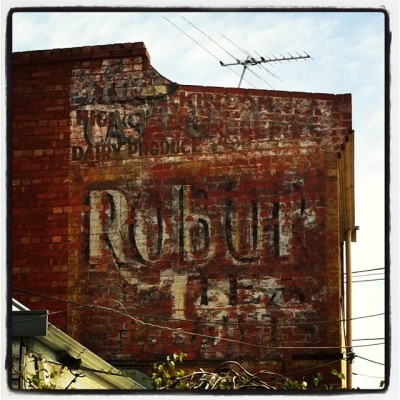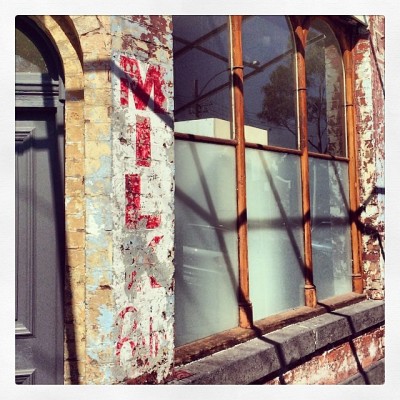Have you been to Carlton? If you have you have very likely sampled their delicious coffee, hoed into a sticky gelato or enjoyed a languid (if sometimes a little loud) dinner at one of the many pizzerias along the main thoroughfares of Lygon and Rathdowne Streets. But wander a little further off the beaten track and you will no doubt find some of the plethora of ghost signs that still haunt the wide cobbled streets and narrow lane ways of Carlton and Carlton North…

Carlton and Carlton North
The subdivision a nd settlement of Carlton came later than that of Fitzroy and Collingwood. By the gold rush of 1851, two thirds of those suburbs were subdivided, often in a haphazard way calculated to maximize profit on the resale of land but when Robert Hoddle, a Government surveyor, came to survey Carlton in 1852, care was taken to lay out streets in an orderly grid, with reserves for open space and religious institutions.
nd settlement of Carlton came later than that of Fitzroy and Collingwood. By the gold rush of 1851, two thirds of those suburbs were subdivided, often in a haphazard way calculated to maximize profit on the resale of land but when Robert Hoddle, a Government surveyor, came to survey Carlton in 1852, care was taken to lay out streets in an orderly grid, with reserves for open space and religious institutions.
By the turn of the century Carlton was home mostly to artisans, workmen and small industries. Two main groups of emigrants, Jews and Italians, found employment and affordable housing there.
America’s commercial approach to the modern, and in particular their modern take on advertising and branding had a significant influence on Australia’s approach to modernism which can still be seen in the streets of Carlton today. City buildings became a new canvas for projecting messages, and the use of modern typeface and lighting (incorporated into neon light and shop front displays) allowed commercial operators to associate their business with progress.

Carlton is a veritable treasure trove of vintage signs. Many of the hand-painted signs around Carlton are likely from the 1940’s and 50’s but some may be as early as the 20’s or even earlier. Ghost signs are more common in working-class areas because in wealthier suburbs where buildings were regularly maintained, they were often painted over. Thankfully in many suburbs councils have been less diligent about their approach to beautification and restoration. In a few key areas such as Carlton we are left with a number of wonderful examples of the skilful work that sign writers once produced and a glimpse into a previous era of advertising.
New-media academic and ghost sign fanatic from Victoria University Dr Schutt believes the current global fascination with ghost signs is a reflection of the growing surge in interest for all things hand-made, hand-grown and recycled which can be seen in the popular ‘grow your own’ movement, knitting clubs and the ‘Hipster’ culture movement.
Hand-painted signs ‘are crafted by real people,’’ Dr Schutt says. ‘‘When you get close to these signs, you can see the strokes that the guys have made with the brushes and, obviously, in the digital era you don’t really get that anymore and it has parallels with the new craft movement and yarn bombing, and that yearning for something that has a human aspect to it that you can see and is tactile.’’
While it is hard to choose a favourite: the ‘Hardy’s Jelly Crystals’ sign is so charming with the little girl and her lamb and I love the simplicity of the ‘B.Horner’s Dairy’ sign, for me, it has to be the sign below for Robur Tea – ‘Robur. It peps you UP. Keeps you YOUNG!” I think it’s a great tagline and layout and love the different fonts and remnants of the bold colours incorporated.
Which is your favourite sign?











How interesting to see lots of signs for tea and coffee. These would have been pretty expensive items I guess so there must have been a lot of competition to win customers. So funny to see Instant Coffee advertised in an area that is now the home of so many great cafes with fabulous coffee.
LikeLike
Can you imagine the horror if any of the cafes in Rathdowne Street tried serving up Bushells Instant Coffee these days?! Ha! I’ve found many old tea and coffee signs in my wandering and they’re often large and well- placed with great graphics. It’s a great point that you make regarding the intense competition within the market for these beverages! Thanks for sharing 🙂
LikeLike
I like the velvet soap sign! Not really relating to soap in my opinion but it caught my eye!
Have you discovered all this history of Melbourne as you’ve gone along to discover the signs?
– Ashleigh
LikeLike
I’m just wondering why these signs are called ghost signs? Sounds really spooky…Like from a horror movie. Did something bad really happen there?
LikeLike
That’s an interesting point! The term ghost signs relates to the remnants of hand-painted advertising signs that still remain to ‘haunt’ the present. I think it’s meant to appeal to people’s curiosity about ghosts and their link to the past rather than creating an feeling or horror. 🙂
LikeLike
This all looks familiar! I grew up in East Brunswick just a few streets from a lot of these. I’m glad to see they’ve been retained unlike a lot of our street art that was sadly removed for the 2006 commonwealth games. My brother in law just bought a place on Brunswick Road (top of Rathdowne) that was an old button factory and they removed the old signage from the front facade. Such a shame!!
LikeLike
Hi Isobel. Thanks for your comments! I love to imagine how beautiful our city would be if more of its rich history was left on show for us to enjoy… Given its working class history Brunswick must have some great signs I’m yet to add to my collection… I must venture over there sometime soon!
LikeLike